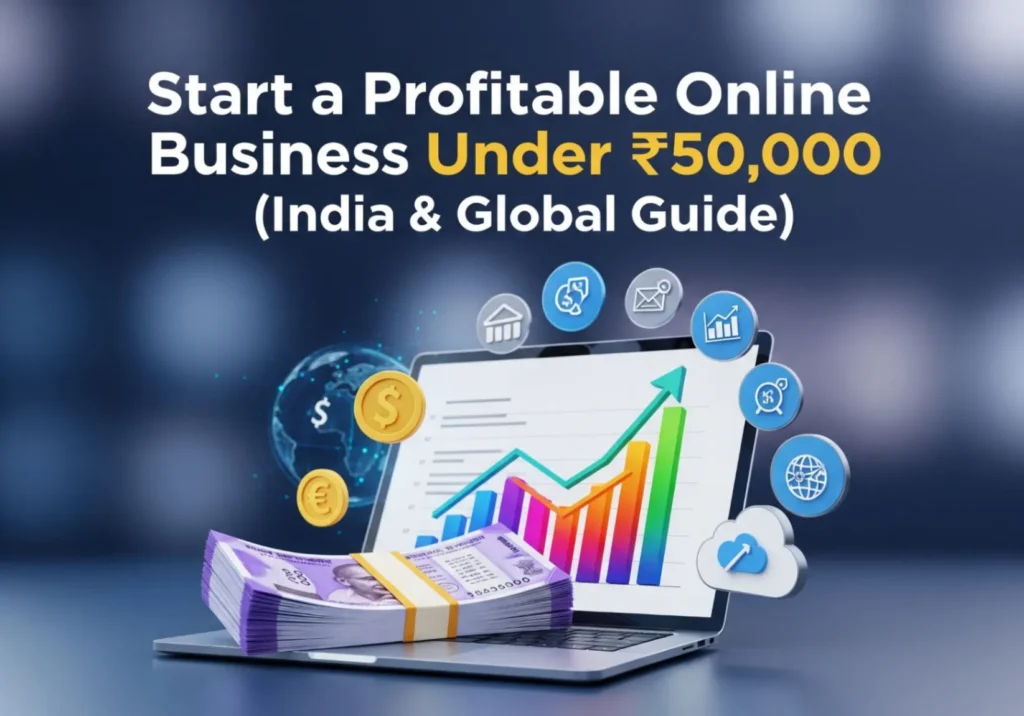Start a Profitable Online Business Under ₹50,000 (India & Global Guide)

Introduction: Your Entrepreneurial Dream is Within Reach
Are you dreaming of becoming your own boss? The digital revolution, especially in places like India, has shattered traditional barriers, opening up incredible opportunities to launch profitable online businesses with limited resources. The old belief that starting a business requires massive capital is no longer true.
If you have a computer, a reliable internet connection, and a starting budget of around ₹50,000 (or the global equivalent), you are already well-equipped to dive into the bustling online marketplace. The explosive growth of e-commerce and internet usage means that billions of potential customers are online right now, actively searching for products, services, and solutions that you could provide.
This comprehensive guide is your roadmap. We will explore several promising and proven online business models perfect for beginners with a low initial investment. We’ll break down the pros, cons, costs, and crucial first steps for each, helping you find the right fit for your unique skills, passions, and entrepreneurial journey.
Why Start an Online Business in 2025? The Opportunity is Now
- Growing Digital Landscape: More people are online and comfortable with digital transactions than ever before. In India alone, the number of internet users is projected to exceed 900 million. This is a massive, accessible market.
- Low Barrier to Entry: Unlike brick-and-mortar businesses, many online models require minimal upfront capital. Your biggest investment is often your time and skills.
- Flexibility & Freedom: Operate from anywhere with an internet connection, offering unparalleled lifestyle flexibility.
- Global Reach: Your potential customer base isn’t limited to your local area; you can reach people across the country and around the world.
- Access to Powerful Tools: An abundance of affordable (and even free) tools for website building, marketing, and payments makes it easier than ever to get started.
Part 1: 6 Profitable Online Business Ideas (Under ₹50,000 Investment)
Here are some top contenders that fit your budget and resources. We’ll dive deep into each one.
1. Freelancing: Monetize Your Existing Skills
Freelancing means offering your skills and expertise to clients on a project basis. This could be anything from writing, editing, graphic design, web development, social media management, virtual assistance, translation, or data entry. You essentially turn your existing abilities into immediate income.
Getting Started:
- Identify Your Core Skill: What are you genuinely good at? What service is in demand? (e.g., Content Writing, Logo Design, Video Editing, Digital Marketing).
- Build a Strong Portfolio: This is your resume. Showcase your best work. If you’re a beginner, create sample projects or offer your services at a reduced rate for 1-2 initial clients to get testimonials and examples. A simple website using Carrd or a Behance profile can work well.
- Join Freelancing Platforms: Create a compelling, detailed profile on sites like Upwork, Fiverr, Freelancer.com, or PeoplePerHour. For Indian freelancers, Truelancer is also a good option.
- Set Your Rates: Research industry standards. As a beginner, you might start slightly lower to be competitive, but don’t undervalue your work. You can price per hour, per project, or with a retainer model.
- Write Winning Proposals: Don’t use generic templates. Read the client’s project description carefully and write a personalized proposal that directly addresses their needs and showcases how your skills can solve their problem.
Pros & Cons
Pros: Very low startup cost. High potential profit based on skills. Flexible schedule. Wide variety of niches.
Cons: High competition on popular platforms. Need to consistently find new clients initially. Managing client expectations and payments requires diligence. Income can be variable.
Costs: Primarily internet fees. Potential software subscriptions (many free options exist). Optional marketing or a simple portfolio website (₹5,000 – ₹10,000).
2. Online Tutoring/Coaching: Share Your Knowledge
If you have expertise in academic subjects, languages, coding, music, art, fitness, or other skills, you can teach others online. Your knowledge is your primary asset.
Getting Started:
- Define Your Niche: Be specific. Not just “Math Tutor,” but “Class 10 CBSE Math Tutor.” Not just “Fitness Coach,” but “Beginner’s Yoga Coach for Working Professionals.”
- Prepare Your Materials: Structure your knowledge into engaging lesson plans. You don’t need fancy equipment; digital materials like PDFs, presentations, and online whiteboards are sufficient.
- Choose Your Platform: You can work independently using video conferencing tools like Zoom or Google Meet. Alternatively, join online tutoring marketplaces like Chegg Tutors, Vedantu, BYJU’s, or Superprof to get access to a student base.
- Attract Students: Market your services via social media (LinkedIn, Instagram), create a simple one-page website, ask for word-of-mouth referrals, or leverage the marketing power of tutoring platforms. Offering a free 15-minute demo class is a great way to attract clients.
Pros & Cons
Pros: Leverages your existing expertise. Minimal investment needed. Growing demand for online education. Scalable through group classes or creating pre-recorded courses later.
Cons: Requires strong communication and teaching skills. Need to consistently attract students. Keeping students engaged online can be challenging.
Costs: Good internet, a decent webcam/microphone (many laptops are sufficient to start), potential platform subscription fees, and optional marketing costs.
3. Selling Handmade Products Online: Turn Creativity into Cash
This involves creating and selling your own unique handcrafted items online – think art prints, custom jewelry, home décor, personalized gifts, sustainable fashion, or artisanal food products.
Getting Started:
- Identify Your Niche & Product: What unique items can you create? Research what’s popular on platforms like Etsy and Instagram. Focus on a niche to stand out (e.g., “minimalist silver jewelry” instead of just “jewelry”).
- Source Your Materials: Find reliable and cost-effective suppliers for your raw materials.
- Set Up Your Online Store: This is easier than ever. Start with marketplaces like Etsy or Amazon Karigar (for Indian artisans). You can also use social commerce features on Instagram and Facebook Shops. For more control, build a simple e-commerce site using Shopify or Dukaan.
- Master Product Photography: High-quality photos are non-negotiable. You don’t need a professional camera; modern smartphones can take amazing pictures with good lighting. Write detailed, descriptive product descriptions.
- Price & Ship Smartly: Calculate all your costs (materials, time, platform fees, packaging) to set a profitable price. Research reliable and affordable shipping options like Shiprocket or local courier services.
Pros & Cons
Pros: Leverages your creative skills. Growing demand for unique, personalized items. High potential for good profit margins. Full control over your brand.
Cons: Requires crafting time and skill. You need to manage production, inventory, and shipping. Marketing is crucial to stand out from the crowd.
Costs: Raw materials, crafting tools, platform fees, packaging, shipping, and marketing. Can easily be started under ₹50,000.
4. Affiliate Marketing: Earn Commissions Promoting Others
Promote other companies’ products or services using unique tracking links. When someone makes a purchase through your link, you earn a commission. This is a content-driven business model.
Getting Started:
- Choose a Niche You Love: Pick a topic you’re genuinely interested in (e.g., travel, personal finance, home gardening, tech gadgets). Your authenticity will be key to building trust.
- Find Affiliate Programs: Join large programs like Amazon Associates or Flipkart Affiliate. Also, look for specific programs for software, courses, or services in your niche.
- Build Your Platform & Audience: This is the most important part. You can start a blog (using WordPress), a YouTube channel, or build a strong social media presence (Instagram, Pinterest). The goal is to become a trusted source of information in your niche.
- Create Valuable Content: Don’t just spam links. Write honest reviews, create helpful tutorials, compare products, and create “best of” lists. Incorporate your affiliate links naturally where they add value for the reader.
- Drive Traffic: Learn basic SEO to get organic traffic to your blog. Use social media and potentially email marketing to bring people to your content.
Pros & Cons
Pros: Very low startup cost. No need to create products or handle inventory/shipping. Flexible work. High potential for passive income over time.
Cons: Takes significant time and effort to build an audience and trust. Income is dependent on traffic and conversion rates. Reliant on the affiliate companies’ terms.
Costs: Minimal if using free platforms. Website hosting/domain (around ₹5,000/year) is highly recommended for building a long-term asset. Optional costs for content creation tools.
5. Dropshipping: E-commerce Without Holding Inventory
You set up an online store to sell products, but you don’t keep any stock yourself. When a customer places an order, you purchase the item from a third-party supplier (often overseas), who then ships it directly to the customer. Your profit is the difference between your selling price and the supplier’s price.
Getting Started:
- Choose a Niche & Products: Research trending products with good profit potential using tools like Google Trends or by analyzing social media. Look for products that solve a problem or cater to a passionate hobby.
- Find Reliable Suppliers: This is critical. Look on platforms like AliExpress or use supplier directories like CJDropshipping. Vet them carefully for product quality, good reviews, and reasonable shipping times. Order samples yourself first.
- Set Up Your Online Store: Use user-friendly platforms like Shopify or WooCommerce (with WordPress) to build your store. Apps like Dsers can automate the process of importing products and forwarding orders to suppliers.
- Market Your Products: This is where most of your budget will go. Drive traffic to your store using social media ads (Facebook, Instagram, TikTok), Google Ads, or influencer marketing.
- Manage Orders & Customer Service: Even though you don’t ship, you are responsible for the customer experience. Process orders efficiently and handle all customer inquiries, returns, and issues.
Pros & Cons
Pros: Low initial investment (no bulk inventory cost). Wide product selection possible. Location independent. Easier to start than traditional e-commerce.
Cons: Lower profit margins. You are reliant on the supplier’s quality and shipping speed. Finding reliable suppliers is a major challenge. High competition. Customer service can be difficult.
Costs: E-commerce platform subscription (e.g., Shopify starts around ₹2,000/month), marketing/advertising costs (often the largest expense), potential website design costs.
6. Digital Art & Personalized Services: Sell Your Digital Creations
Create and sell digital goods like custom logos, illustrations, design templates (for social media, resumes, etc.), fonts, stock photos, or offer personalized digital services like virtual interior design, virtual assistant tasks, or online event planning.
Getting Started:
- Define Your Offering: What specific digital product or service will you sell? (e.g., “Custom pet portraits,” “Canva templates for small businesses”).
- Build a Stellar Portfolio: Showcase your best digital work or service capabilities on a platform like Behance, Dribbble, or your own simple website.
- Choose Your Selling Platforms: Use marketplaces like Etsy (great for digital downloads), Creative Market, or Fiverr (for services). For more control, build your own website using a platform like Shopify with a digital downloads app.
- Market Your Skills: Use visual social media platforms like Instagram and Pinterest. Join relevant online communities (e.g., Facebook groups for small business owners) to offer value and market your services.
- Deliver & Communicate: Provide high-quality digital files or services promptly and maintain clear, professional communication with your clients.
Pros & Cons
Pros: Very low production cost for digital goods (create once, sell many times). High potential profit margins. Growing demand for personalized digital content. Global reach.
Cons: Requires specific artistic or technical skills. Need to protect digital work from piracy. Finding clients/customers requires consistent marketing effort.
Costs: Potential software subscriptions (e.g., Adobe Creative Cloud, Canva Pro), website/portfolio costs, and marketing expenses.
Part 2: The Universal Blueprint for Launching Your Online Business
Regardless of the model you choose, these foundational steps are crucial for success.

Your Step-by-Step Launch Plan
- Phase 1: Research & Ideation (The Foundation). Don’t skip this! Validate your idea. Is there a real market for it? Who are your competitors? Who is your ideal customer? Use tools like Google Trends and social media searches to gauge interest.
- Phase 2: Build Your Brand Identity. Choose a memorable business name. Create a simple but professional logo (you can use Canva). Define your brand voice and colors. Consistency builds trust.
- Phase 3: Establish Your Online Presence. Create professional profiles on relevant platforms. Secure social media handles. We highly recommend building a simple one-page website (using tools like Carrd, Wix, or a simple WordPress theme) to act as your central hub. It builds immense credibility.
- Phase 4: Understand Basic Legal & Tax Requirements (India Specific). You can start as a Sole Proprietorship easily. If your annual turnover exceeds ₹20 lakhs, GST registration is required. Keep a simple record of your income and expenses. (Disclaimer: Always consult a professional CA for specific advice).
- Phase 5: Set Up Financial Management. Open a separate bank account for your business to track finances easily. Set up payment gateways like Razorpay or Instamojo to accept payments professionally.
- Phase 6: The Modern Marketing Playbook. Start with free marketing: create valuable content on social media, learn basic SEO for your website, network in online communities, and encourage word-of-mouth referrals. Once you have revenue, consider reinvesting a small amount into targeted paid ads.
- Phase 7: Launch and Get Feedback. Don’t wait for perfection. Launch your service or product and get it in front of real customers. Their feedback is the most valuable data you will ever receive. Be prepared to listen, adapt, and improve.
Essential Tools for Your Low-Budget Startup
- Communication: Gmail, WhatsApp, Zoom (free plan is excellent).
- Collaboration & Productivity: Google Workspace (Docs, Sheets), Trello or Notion (for project management).
- Design (Basic): Canva is an absolute must-have. The free plan is incredibly powerful.
- AI Assistants: Use ChatGPT or Google’s Gemini for brainstorming ideas, writing marketing copy, and summarizing research.
Conclusion: Your Entrepreneurial Journey Starts Now!
Starting a profitable online business with under ₹50,000 is not just a dream; it’s an achievable reality in 2025. Models like freelancing, online tutoring, selling handmade goods, affiliate marketing, dropshipping, and offering digital services provide fantastic opportunities with low entry barriers.
Key Recommendations for Success:
- Choose Wisely: Select a model that genuinely aligns with your skills, interests, and resources. Passion will fuel you through the hard times.
- Start Small & Focus: Don’t try to do everything at once. Master one service or product first before expanding.
- Build a Strong Foundation: Prioritize quality, excellent customer service, and building a good reputation from day one.
- Be Patient & Persistent: Success takes time, consistent effort, and a commitment to continuous learning. Don’t get discouraged by slow beginnings.
- Keep Learning: The online world changes fast. Stay updated on trends in your niche, marketing, and technology.
Your entrepreneurial journey begins not with a giant leap, but with the first small, deliberate step. Take action, learn along the way, and build the online business you’ve been dreaming of!

Your Turn!
Which of these online business ideas are you most excited about? What’s the first step you’re going to take this week to get started? Share your plans in the comments below!